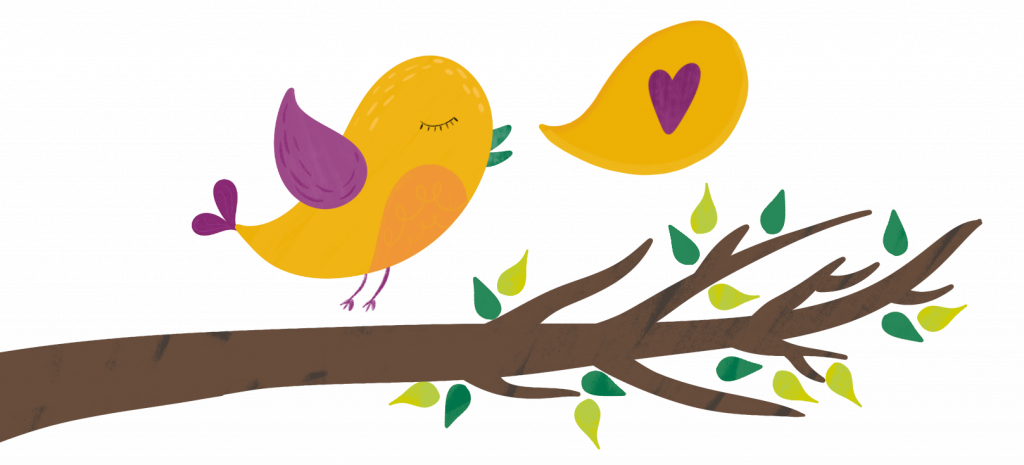Are your kinder or Pre-K students ready to learn the letter r sound?
There’s no one agreed-upon best sequence to introduce letters. Personally, I don’t go in order from a-z. I start with the most common letters (such as s, a, t, p, i, n, and m) that young readers will find in simple words. You may have a different sequence that you prefer.
While I don’t have strong feelings about the particular order in which letters and sounds are introduced, I do have an enthusiastic preference for HOW to introduce each sound and its related letter.
Let’s look at letter sound r as an example. Many programs will ask you to say something like:
“This is the letter r (showing the printed letter). R says /r/, as in rainbow (showing a picture of a rainbow). Repeat after me, R, rainbow, /r/”.
That’s one way to do it. It’s how I did it for about a decade.
However, after years of diving into research studies and professional books, as well as attending countless trainings in structured literacy, I’ve made simple changes to my instructional routine of teaching letter sounds and have seen great results.
I’d love to share this easy, targeted, and effective routine with you. I hope you get some inspiration from the steps described below.
Routine for Introducing the Letter R and Its Sound
You can play this video to introduce the letter r sound to your students and you’ll cover all the steps that are explained below.
Start with speech.
Why?
Learning is more likely to stick when we connect new information to existing knowledge. We know to activate prior knowledge for reading comprehension, so it makes sense to use that same process when teaching letter sounds. Since students have much more experience talking than reading at this young age, it’s intuitive to start with a sound (existing knowledge) and then link it to a printed letter (new knowledge).
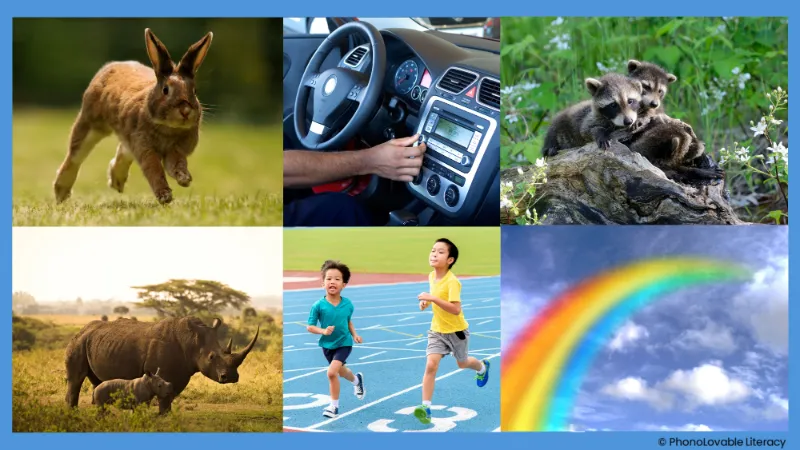

How?
Say 3-6 words that begin with the letter r, such as rabbit, radio, raccoon, rhino, race, and rainbow. Ask children to repeat each word after you say it. Display a picture of each word if you can. Showing visuals helps add interest and can be especially useful for students with limited English vocabulary and kids who struggle with attention. Tell students that all of these words begin with the sound /r/. If you don’t have pictures, that’s okay! You could even ask students to close their eyes to help them listen carefully and repeat each word you say.
Draw attention to what your mouth does when you make the /r/ sound.
Why?
A mouth articulation card like the one shown below provides our children with a concrete representation of an abstract concept. It adds a multisensory connection when we help students pay attention to how our faces look and feel when the sound is being produced.
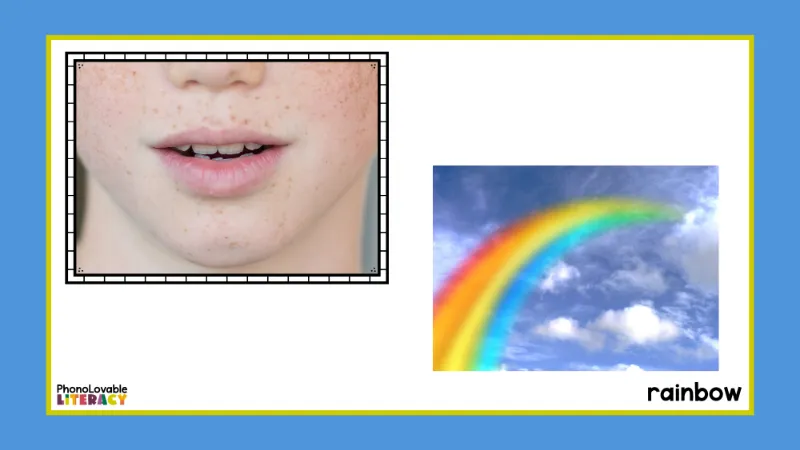

How?
Ask students to notice what their mouth is doing to make the sound /r/. If you teach a small group, hold up a mirror to let children see for themselves. If you have a large group, display a sound articulation (mouth pic) card on your whiteboard or smart TV if you have one. Draw attention to the fact that we need to round our tongues to make the sound. Model this and point to your own mouth or the sound articulation card. Ask students to make the /r/ sound and feel the movement of their tongue.
Introduce the printed letter with an EMBEDDED mnemonic.
Why?
Research studies have demonstrated that using embedded images, keyword pictures displayed within the letter as opposed to apart from the letter (above, below, beside), resulted in student improvement in both the acquisition AND retention of letter-sound correspondences. Using pictures, especially ones of relatable objects, to help kids connect letter-sound relationships makes so much sense. But it was great to read research studies to back this up!
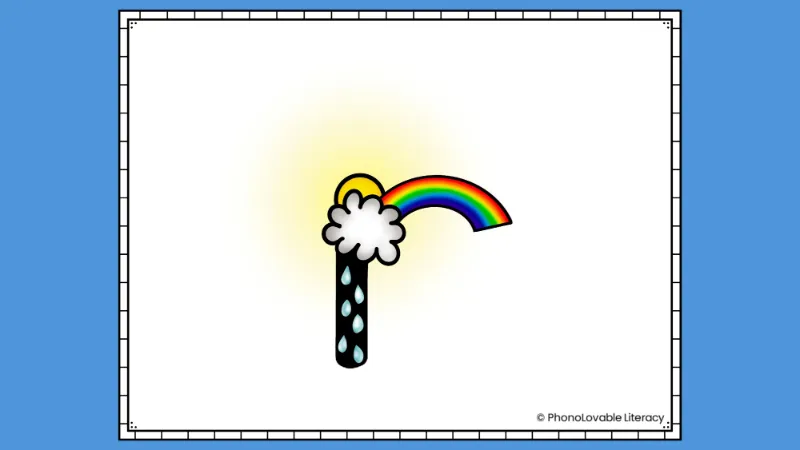

How?
Here is where you’ll first show your students the actual letter. But not just a plain letter, an embedded letter. The image of a keyword such as a rainbow embedded within the letter r helps solidify the connection between letter and sound. The shape of the rainbow, corresponding to the shape of the lowercase letter r, will serve as a reminder of the phoneme-grapheme relationship. I also like to choose images/keywords that are appealing to kids, which is why we chose rainbow as opposed to rat.
Model and practice letter formation.
Why?
Reading and writing have a complementary relationship and should be taught together. We teach letter sounds so that students may not only decode new words but learn to write them as well.
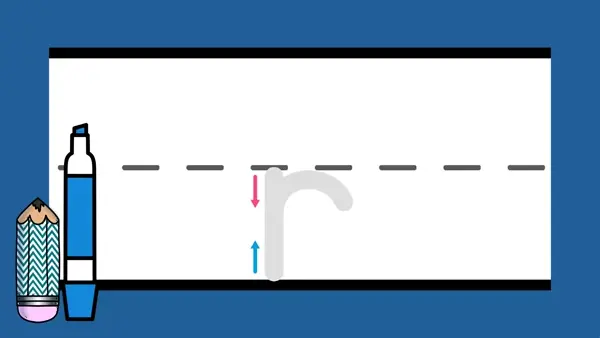

How?
I prefer to keep my letter formation language simple. You may have different wording from a program you’ve used, or you may wish to change up how you say this, but here’s what I say as I model how to write the lowercase letter r.
“Start at the middle line. Little line down. Push up and curve a little bit around.” I model this on a whiteboard and/or show an animated slide on my computer (in small group) or smart TV (in whole group). Ask students to follow along with their fingers in the air. If children are seated at desks, ask them to finger-write the letter r on the desk.
I usually have students practice without a writing utensil a few times before I ask them to write with a dry-erase marker or pencil. This is just so I can make sure they’ve got the movements down or at least the letter-formation language before they try it on paper.
Research-Aligned Alphabet Resources
Here are my recommendations for introducing the letter r and the rest of the letters to your kindergarten or Pre-K students:
Initial Sound Slides: These no-prep slides introduce each letter sound in the most effective and efficient way. With each click, students will see interesting photographs containing the beginning sound, a photo of a child making the sound along with a keyword image, the letter with an embedded mnemonic image, and lastly, an animated letter formation slide (one for uppercase and one for lowercase letters).
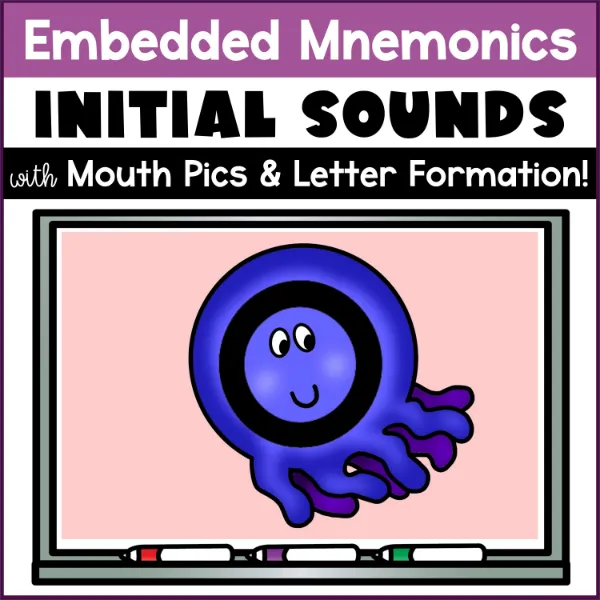

Mnemonic Alphabet Articulation Mouth Cards | Alphabet Posters with Real Pictures: If you prefer a paper option or don’t have access to digital resources, you may like these printable, 1-page posters of mouth pics along with the embedded mnemonic letters. It’s also a nice way to display the alphabet if you have classroom wall space.
Alphabet Picture Cards with Embedded Mnemonics: This set of printable pages comes with embedded letter cards in two sizes. Teach phonemes for 21 consonants, 5 short vowels, AND consonant digraphs WH, TH, SH, CH, and CK.
Get a free set of small embedded letter cards when you join us in our newsletter community!
Looking for an “everything bundle” of embedded letter resources, including digital slides, letter cards, worksheets, games, and more? Save nearly 50% and get all 12 resources. Watch as your students quickly and effectively master letter sounds so they can begin the even more exciting process of learning how to read and write words!
Sources:
Ehri, L. C., Deffner, N. D., & Wilce, L. S. (1984). Pictorial mnemonics for phonics. Journal of Educational Psychology, 76(5), 880–893. https://doi.org/10.1037/0022-0663.76.5.880
Ehri, L. C. (2013). Orthographic Mapping in the Acquisition of Sight Word Reading, Spelling Memory, and Vocabulary Learning. Scientific Studies of Reading, 18(1), 5–21. https://doi.org/10.1080/10888438.2013.819356
Ehri, L.C. (2022). What Teachers Need to Know and Do to Teach Letter–Sounds, Phonemic Awareness, Word Reading, and Phonics. The Reading Teacher, 76(1), 53-61. https://doi.org/10.1002/trtr.2095
McNamara, G. (2012). The effectiveness of embedded picture mnemonic alphabet cards on letter recognition and letter sound knowledge. Theses and Dissertations. 302. https://rdw.rowan.edu/etd/302
Shmidman, A., & Ehri, L. (2010). Embedded Picture Mnemonics to Learn Letters. Scientific Studies of Reading, 14(2), 159–182. https://doi.org/10.1080/10888430903117492
